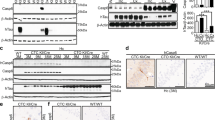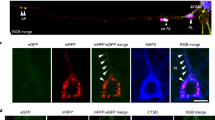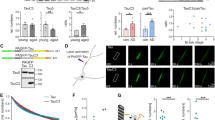Abstract
Studies of post-mortem tissue have shown that the location of fibrillar tau deposits, called neurofibrillary tangles (NFT), matches closely with regions of massive neuronal death1,2, severe cytological abnormalities3, and markers of caspase activation and apoptosis4,5,6, leading to the idea that tangles cause neurodegeneration in Alzheimer’s disease and tau-related frontotemporal dementia. However, using in vivo multiphoton imaging to observe tangles and activation of executioner caspases in living tau transgenic mice (Tg4510 strain), we find the opposite: caspase activation occurs first, and precedes tangle formation by hours to days. New tangles form within a day. After a new tangle forms, the neuron remains alive and caspase activity seems to be suppressed. Similarly, introduction of wild-type 4-repeat tau (tau-4R) into wild-type animals triggered caspase activation, tau truncation and tau aggregation. Adeno-associated virus-mediated expression of a construct mimicking caspase-cleaved tau into wild-type mice led to the appearance of intracellular aggregates, tangle-related conformational- and phospho-epitopes, and the recruitment of full-length endogenous tau to the aggregates. On the basis of these data, we propose a new model in which caspase activation cleaves tau to initiate tangle formation, then truncated tau recruits normal tau to misfold and form tangles. Because tangle-bearing neurons are long-lived, we suggest that tangles are ‘off pathway’ to acute neuronal death. Soluble tau species, rather than fibrillar tau, may be the critical toxic moiety underlying neurodegeneration.
This is a preview of subscription content, access via your institution
Access options
Subscribe to this journal
Receive 51 print issues and online access
$199.00 per year
only $3.90 per issue
Buy this article
- Purchase on Springer Link
- Instant access to full article PDF
Prices may be subject to local taxes which are calculated during checkout




Similar content being viewed by others
References
Ramsden, M. et al. Age-dependent neurofibrillary tangle formation, neuron loss, and memory impairment in a mouse model of human tauopathy (P301L). J. Neurosci. 25, 10637–10647 (2005)
Gómez-Isla, T. et al. Neuronal loss correlates with but exceeds neurofibrillary tangles in Alzheimer’s disease. Ann. Neurol. 41, 17–24 (1997)
Augustinack, J. C., Schneider, A., Mandelkow, E. M. & Hyman, B. T. Specific tau phosphorylation sites correlate with severity of neuronal cytopathology in Alzheimer’s disease. Acta Neuropathol. 103, 26–35 (2002)
Ramalho, R. M. et al. Apoptosis in transgenic mice expressing the P301L mutated form of human tau. Mol. Med. 14, 309–317 (2008)
Guo, H. et al. Active caspase-6 and caspase-6-cleaved tau in neuropil threads, neuritic plaques, and neurofibrillary tangles of Alzheimer’s disease. Am. J. Pathol. 165, 523–531 (2004)
Rohn, T. T. et al. Correlation between caspase activation and neurofibrillary tangle formation in Alzheimer’s disease. Am. J. Pathol. 158, 189–198 (2001)
Santacruz, K. et al. Tau suppression in a neurodegenerative mouse model improves memory function. Science 309, 476–481 (2005)
Spires, T. L. et al. Region-specific dissociation of neuronal loss and neurofibrillary pathology in a mouse model of tauopathy. Am. J. Pathol. 168, 1598–1607 (2006)
Spires-Jones, T. L. et al. In vivo imaging reveals dissociation between caspase activation and acute neuronal death in tangle-bearing neurons. J. Neurosci. 28, 862–867 (2008)
de Calignon, A., Spires-Jones, T. L., Pitstick, R., Carlson, G. A. & Hyman, B. T. Tangle-bearing neurons survive despite disruption of membrane integrity in a mouse model of tauopathy. J. Neuropathol. Exp. Neurol. 68, 757–761 (2009)
Styren, S. D., Hamilton, R. L., Styren, G. C. & Klunk, W. E. X-34, a fluorescent derivative of Congo red: a novel histochemical stain for Alzheimer’s disease pathology. J. Histochem. Cytochem. 48, 1223–1232 (2000)
Velasco, A. et al. Detection of filamentous tau inclusions by the fluorescent Congo red derivative FSB [(trans,trans)-1-fluoro-2,5-bis(3-hydroxycarbonyl-4-hydroxy)styrylbenzene]. FEBS Lett. 582, 901–906 (2008)
Rissman, R. A. et al. Caspase-cleavage of tau is an early event in Alzheimer disease tangle pathology. J. Clin. Invest. 114, 121–130 (2004)
Zhang, Q., Zhang, X. & Sun, A. Truncated tau at D421 is associated with neurodegeneration and tangle formation in the brain of Alzheimer transgenic models. Acta Neuropathol. 117, 687–697 (2009)
Basurto-Islas, G. et al. Accumulation of aspartic acid421- and glutamic acid391-cleaved tau in neurofibrillary tangles correlates with progression in Alzheimer disease. J. Neuropathol. Exp. Neurol. 67, 470–483 (2008)
Guillozet-Bongaarts, A. L. et al. Tau truncation during neurofibrillary tangle evolution in Alzheimer’s disease. Neurobiol. Aging 26, 1015–1022 (2005)
Delobel, P. et al. Analysis of tau phosphorylation and truncation in a mouse model of human tauopathy. Am. J. Pathol. 172, 123–131 (2008)
Horowitz, P. M. et al. Early N-terminal changes and caspase-6 cleavage of tau in Alzheimer’s disease. J. Neurosci. 24, 7895–7902 (2004)
Guillozet-Bongaarts, A. L. et al. Pseudophosphorylation of tau at serine 422 inhibits caspase cleavage: in vitro evidence and implications for tangle formation in vivo. J. Neurochem. 97, 1005–1014 (2006)
Jaworski, T. et al. AAV-tau mediates pyramidal neurodegeneration by cell-cycle re-entry without neurofibrillary tangle formation in wild-type mice. PLoS One 4, e7280 (2009)
Andorfer, C. et al. Hyperphosphorylation and aggregation of tau in mice expressing normal human tau isoforms. J. Neurochem. 86, 582–590 (2003)
Gamblin, T. C. et al. Caspase cleavage of tau: linking amyloid and neurofibrillary tangles in Alzheimer’s disease. Proc. Natl Acad. Sci. USA 100, 10032–10037 (2003)
Yin, H. & Kuret, J. C-terminal truncation modulates both nucleation and extension phases of tau fibrillization. FEBS Lett. 580, 211–215 (2006)
Ding, H., Matthews, T. A. & Johnson, G. V. Site-specific phosphorylation and caspase cleavage differentially impact tau-microtubule interactions and tau aggregation. J. Biol. Chem. 281, 19107–19114 (2006)
Mocanu, M. M. et al. The potential for β-structure in the repeat domain of tau protein determines aggregation, synaptic decay, neuronal loss, and coassembly with endogenous Tau in inducible mouse models of tauopathy. J. Neurosci. 28, 737–748 (2008)
Wang, Y. et al. Tau fragmentation, aggregation and clearance: the dual role of lysosomal processing. Hum. Mol. Genet. 18, 4153–4170 (2009)
Park, S. Y., Tournell, C., Sinjoanu, R. C. & Ferreira, A. Caspase-3- and calpain-mediated tau cleavage are differentially prevented by estrogen and testosterone in β-amyloid-treated hippocampal neurons. Neuroscience 144, 119–127 (2007)
Gossen, M. & Bujard, H. Tight control of gene expression in mammalian cells by tetracycline-responsive promoters. Proc. Natl Acad. Sci. USA 89, 5547–5551 (1992)
Mayford, M. et al. Control of memory formation through regulated expression of a CaMKII transgene. Science 274, 1678–1683 (1996)
Skoch, J., Hickey, G. A., Kajdasz, S. T., Hyman, B. T. & Bacskai, B. J. in Amyloid proteins: methods and protocols (ed. Sigurdsson, E. M.) 349–364 (Humana Press, 2004)
Acknowledgements
This work was supported by AG08487, AG 026249, K99 AG033670-01A1, Alzheimer’s disease Drug Discovery Foundation, Harvard Medical School Shore Award. We thank W. E. Klunk for his generous gift of compound X-34. A.d.C. is a student in the B2M programme (Université Pierre and Marie Curie, Paris, France) and the results in this manuscript will be presented in her thesis.
Author Contributions A.d.C. and L.M.F. carried out the experiments described and helped design the experiments; A.d.C. wrote the manuscript. T.L.S.-J. developed the caspase reagents and contributed to experimental design and analysis and manuscript preparation. R.P. and G.A.C. provided the Tg4510 animals and contributed to characterization of this line. B.J.B. contributed to experimental design and development of multiphoton imaging protocols to allow multicolour, multiday imaging. B.T.H. assisted with conception and design of the experiments, assisted with data analysis, manuscript preparation, and provided funding for the study.
Author information
Authors and Affiliations
Corresponding author
Ethics declarations
Competing interests
The authors declare no competing financial interests.
Supplementary information
Supplementary Figures
This file contains Supplementary Figures 1-6 with legends. (PDF 948 kb)
Rights and permissions
About this article
Cite this article
de Calignon, A., Fox, L., Pitstick, R. et al. Caspase activation precedes and leads to tangles. Nature 464, 1201–1204 (2010). https://doi.org/10.1038/nature08890
Received:
Accepted:
Published:
Issue Date:
DOI: https://doi.org/10.1038/nature08890
This article is cited by
-
Exploring the significance of caspase-cleaved tau in tauopathies and as a complementary pathology to phospho-tau in Alzheimer’s disease: implications for biomarker development and therapeutic targeting
Acta Neuropathologica Communications (2024)
-
Friend or foe: role of pathological tau in neuronal death
Molecular Psychiatry (2023)
-
Complicated Role of Post-translational Modification and Protease-Cleaved Fragments of Tau in Alzheimer’s Disease and Other Tauopathies
Molecular Neurobiology (2023)
-
Pentoxifylline as Add-On Treatment to Donepezil in Copper Sulphate-Induced Alzheimer’s Disease-Like Neurodegeneration in Rats
Neurotoxicity Research (2023)
-
Chaperone-mediated autophagy in neurodegenerative diseases: mechanisms and therapy
Molecular and Cellular Biochemistry (2023)
Comments
By submitting a comment you agree to abide by our Terms and Community Guidelines. If you find something abusive or that does not comply with our terms or guidelines please flag it as inappropriate.



